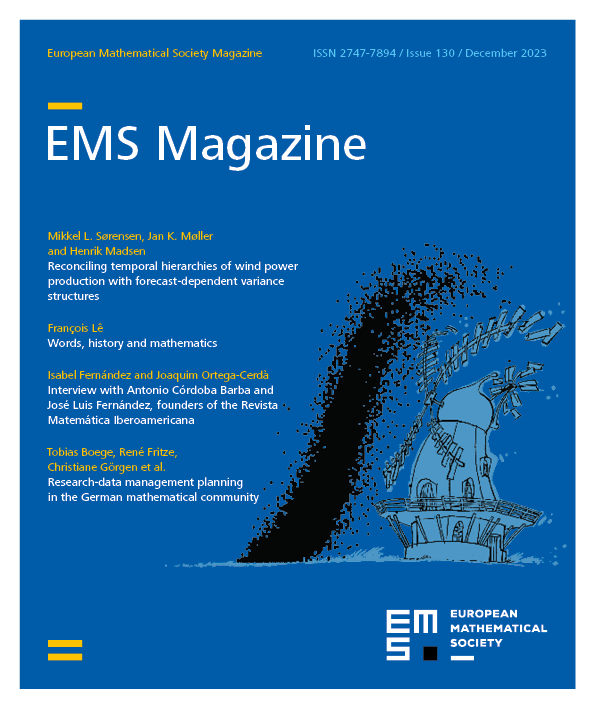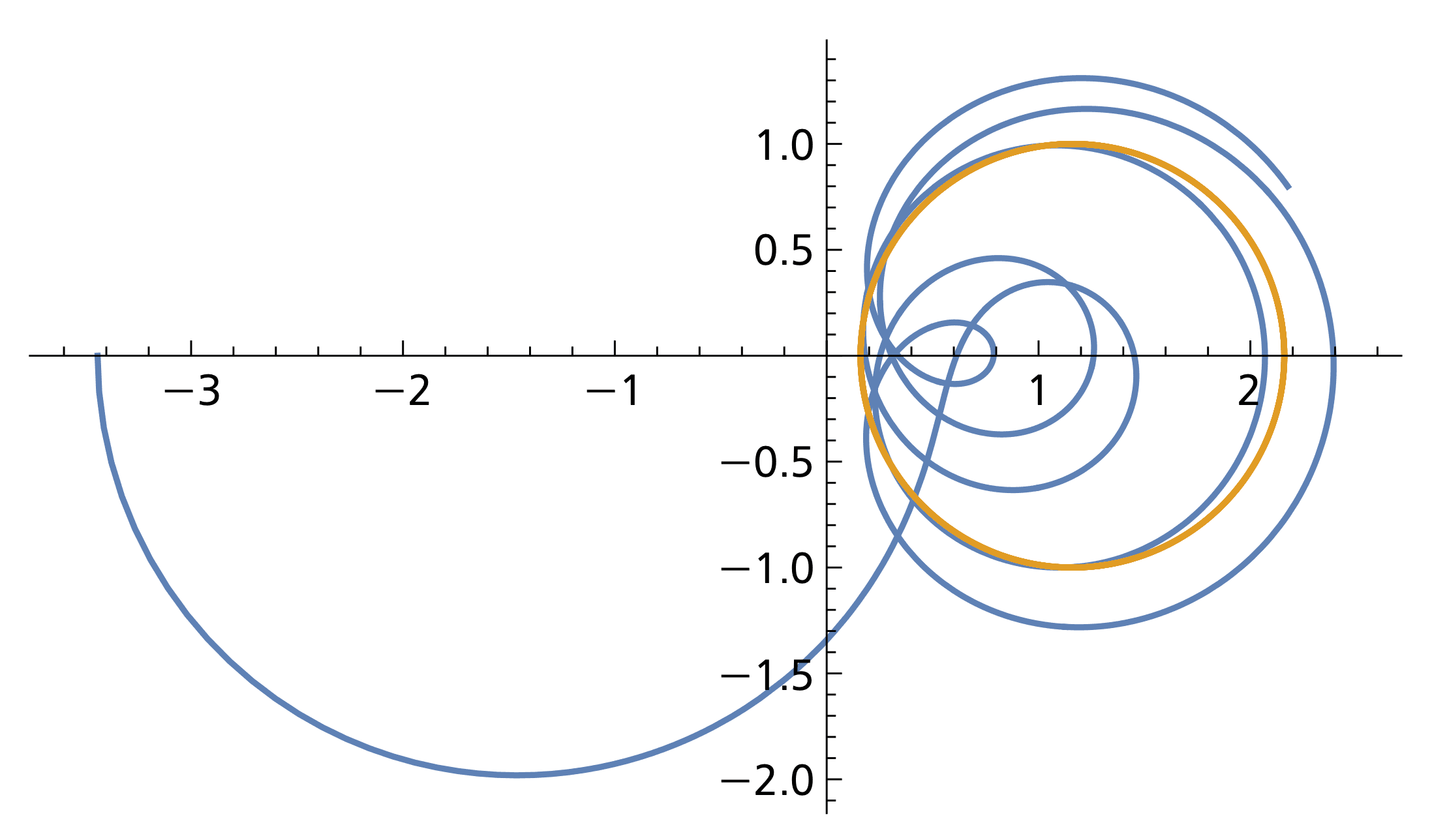This note deals with an application of Voronin’s universality theorem for the Riemann zeta-function . In particular, we show that every plane smooth curve appears, up to a small error, in the curve generated by the values for real , where is fixed. In this sense, the values of the zeta-function on any such vertical line provide an atlas for plane curves.
1 Curves generated by the Riemann zeta-function
Curves appear naturally in life, perhaps not as ideal objects, as Euclid defined a line as “a length without breadth” in his Elements, but as orbits of planets, trajectories in physics and technology, or drawings in art. Taking into account their variety, it might be surprising that one can find them all realized in a single curve. Following Tolkien, we may state this also as a “Lord of the Curves” poem:
One Curve to rule them all, One Curve to find them, One Curve to bring them all, And in the plane bind them.
Of course, our statement above needs to be clarified. Here and in the sequel we consider only finite and smooth curves on the plane, meaning that for each of them there exists a parametrization of the form
such that has a non-vanishing first derivative and a continuous second derivative (see [5 M. P. do Carmo, Differential geometry of curves and surfaces. Prentice-Hall, Englewood Cliffs, NJ (1976) ]); this includes line segments, ellipses, and many more curves that easily come to mind. The single curve that realizes all these smooth curves, however, is an artifact and has to be infinite for obvious reasons. In this respect, our theorem below has some implications to our understanding of infinity.
This infinite curve originates from the Riemann zeta-function, defined by
where with the imaginary unit (in the upper half-plane) is a complex variable with real part . The complex-valued function plays a central role in analytic number theory and the distribution of prime numbers in particular (see [9 H. L. Montgomery and R. C. Vaughan, Multiplicative number theory. I. Classical theory. Cambridge Studies in Advanced Mathematics 97, Cambridge University Press, Cambridge (2007) ]). For our result, we need to allow deviations by a quantity as small as desired. The mathematical language allows for a precise formulation:
Let and be fixed. Then, every plane curve is, up to an error of order and affine translation, contained in the graph of the curve .
Here, of course, we regard any curve on the Euclidean plane, via , also as a curve on the complex plane.
Proof. The proof relies on Voronin’s celebrated universality theorem [12 S. M. Voronin, Theorem on the “universality” of the Riemann zeta-function. (In Russian.) Izv. Akad. Nauk SSSR Ser. Mat. 39, 475–486, 703 (1975); English translation: Math. USSR, Izv. 9 (1975), 443–453 (1976) ] from 1975 which states, roughly speaking, that certain shifts of the zeta-function approximate every zero-free analytic function, defined on a sufficiently small disk – a remarkable approximation property!
For our purpose, we recall the universality theorem [12 S. M. Voronin, Theorem on the “universality” of the Riemann zeta-function. (In Russian.) Izv. Akad. Nauk SSSR Ser. Mat. 39, 475–486, 703 (1975); English translation: Math. USSR, Izv. 9 (1975), 443–453 (1976) ] in a stronger form: Suppose that is a compact subset of the strip with connected complement, and let be a non-vanishing continuous function on which is analytic in the interior of . Then, for every , the set of real satisfying
has positive lower density (see [11 J. Steuding, Value-distribution of L-functions. Lecture Notes in Mathematics 1877, Springer, Berlin (2007) ]). The main differences from Voronin’s original statement in [12 S. M. Voronin, Theorem on the “universality” of the Riemann zeta-function. (In Russian.) Izv. Akad. Nauk SSSR Ser. Mat. 39, 475–486, 703 (1975); English translation: Math. USSR, Izv. 9 (1975), 443–453 (1976) ] are the positive lower density of the set of shifts (which is already implicit in Voronin’s proof, but not in his formulation of the theorem) and the rather general set , where Voronin considered only disks; this is first apparent in Gonek’s PhD thesis [6 S. M. Gonek, Analytic properties of zeta and L-functions. PhD Thesis, University of Michigan (1979) ] and later in Bagchi’s PhD thesis [2 B. Bagchi, The statistical behaviour and universality properties of the Riemann zeta-function and other allied Dirichlet series, PhD Thesis, Calcutta, Indian Statistical Institute (1981) ]. The topological restriction on follows from Mergelyan’s approximation theorem and its limitations (see [8 S. N. Mergelyan, Uniform approximations to functions of a complex variable. (In Russian.) Uspehi Matem. Nauk (N.S.) 7, 31–122 (1952); English translation: Am. Math. Soc. Transl. 101 (1954) ] and [11 J. Steuding, Value-distribution of L-functions. Lecture Notes in Mathematics 1877, Springer, Berlin (2007) , p. 107]). We will also make use of the following observation, due to Andersson [1 J. Andersson, Lavrent’ev’s approximation theorem with nonvanishing polynomials and universality of zeta-functions. In New directions in value-distribution theory of zeta and L-functions, pp. 7–10, Shaker Verlag, Aachen (2009) ]: If has empty interior, then the target function in the universality theorem is allowed to have zeros.
In order to describe curves, the concept of curvature of a smooth curve is essential. We omit the technical definition of this notion, and only mention that the curvature of a curve (with a suitable parametrization (1)) is a real-valued function that measures the deviation of the curve from a straight line. It is a well-known fact that a smooth plane curve is determined by its curvature; this follows from the fundamental theorem of the local theory of curves (see [5 M. P. do Carmo, Differential geometry of curves and surfaces. Prentice-Hall, Englewood Cliffs, NJ (1976) ]). Let be the curvature of a parametrized plane curve (1) with respect to the arc length (in order to have a unique representation). Define
Then, a model of the curve with curvature on the complex plane is given by the parametrization
where ranges through the interval . By the universality theorem, more precisely Andersson’s observation and (3) with , for every , there exists such that
∎
In view of the positive lower density for the set of real shifts that lead to the desired approximation of the target function, it follows that any plane curve appears infinitely often, up to a tiny error bounded by , in any curve with any fixed (even with positive lower density). In this sense, the zeta-function provides a single plane curve that contains all the plane curves with an error too small to be seen with the naked eye! Note that the Planck length is about meters and, according to quantum mechanics, one cannot see anything smaller than this tiny quantity.
Hence, the values of the zeta-function on any vertical line in the right open half of the critical strip provide an atlas for plane curves (where atlas should be understood as in geography, rather than as in the mathematical context of manifolds).
We note that, in view of the universality theorem, the target function just needs to be continuous if has empty interior. This even allows to approximate space-filling curves like the Peano curve, for which a continuous representation (1) exists (see [10 H. Sagan, Space-filling curves. Universitext, Springer-Verlag, New York (1994) ] and Figure 2 for the Peano curve as the limit of an iteration). This Peano curve maps the unit interval onto the unit square . On the contrary, the map is differentiable and, therefore, if is restricted to a bounded interval, the corresponding curve necessarily has finite length. That nevertheless the approximation of a space-filling curve is possible follows from the inaccuracy hidden behind the epsilon.
Is it possible to extend these results further? To answer this question we recall that, more than a century ago, Bohr (the mathematician Harald, younger brother of the physicist Niels) and Courant [3 H. Bohr and R. Courant, Neue Anwendungen der Theorie der Diophantischen Approximationen auf die Riemannsche Zetafunktion. J. Reine Angew. Math. 144, 249–274 (1914) ] proved that is dense in for every fixed (which means that one can find a value for some real in every neighbourhood of every point of the complex plane). Of course, this result also follows from universality (by choosing a constant target function). For the critical line, however, it is unknown whether is dense in the complex plane or not. Universality applies neither to the critical line (because of too many zeros of ), nor to any vertical line with (because of the absolute convergence of the defining series (2)). These limitations also hold for the approximation of plane curves, which is obvious for (since then ); for , however, this follows from a result of Gonek and Montgomery [7 S. M. Gonek and H. L. Montgomery, Spirals of the zeta function I. In Analytic number theory, pp. 127–131, Springer, Cham (2015) ], who showed that the curvature of is negative for and something similar holds for as well. The latter result is conditional subject to the truth of the famous, yet unproven, Riemann Hypothesis that
This open conjecture is one of the seven Millennium Problems in mathematics.
We conclude with a related problem in the universe of numbers. Does every finite pattern of digits appear in the infinite decimal fraction expansion of the circle number ? There exist real numbers with this property, for example the Champernowne constant (built from the positive integers in ascending order) and it has been proven that almost all real numbers have this property (such numbers are called normal; see [4 K. Dajani and C. Kraaikamp, Ergodic theory of numbers. Carus Mathematical Monographs 29, Mathematical Association of America, Washington, DC (2002) ]); however, the case of special numbers is difficult and wide open in the case of .
A more detailed account of our study with additional results in this context will appear elsewhere.
Acknowledgements. With this short note the authors want to express their gratitude to the EMS for the financial support of the conference “Universality, Zeta-Functions, and Chaotic Operators” at Centre international de rencontres mathématiques in Luminy in August 2023. We are also grateful to the referee for carefully reading our note. The first author was supported by the Austrian Science Fund (FWF): project M 3246-N.
References
- J. Andersson, Lavrent’ev’s approximation theorem with nonvanishing polynomials and universality of zeta-functions. In New directions in value-distribution theory of zeta and L-functions, pp. 7–10, Shaker Verlag, Aachen (2009)
- B. Bagchi, The statistical behaviour and universality properties of the Riemann zeta-function and other allied Dirichlet series, PhD Thesis, Calcutta, Indian Statistical Institute (1981)
- H. Bohr and R. Courant, Neue Anwendungen der Theorie der Diophantischen Approximationen auf die Riemannsche Zetafunktion. J. Reine Angew. Math. 144, 249–274 (1914)
- K. Dajani and C. Kraaikamp, Ergodic theory of numbers. Carus Mathematical Monographs 29, Mathematical Association of America, Washington, DC (2002)
- M. P. do Carmo, Differential geometry of curves and surfaces. Prentice-Hall, Englewood Cliffs, NJ (1976)
- S. M. Gonek, Analytic properties of zeta and L-functions. PhD Thesis, University of Michigan (1979)
- S. M. Gonek and H. L. Montgomery, Spirals of the zeta function I. In Analytic number theory, pp. 127–131, Springer, Cham (2015)
- S. N. Mergelyan, Uniform approximations to functions of a complex variable. (In Russian.) Uspehi Matem. Nauk (N.S.) 7, 31–122 (1952); English translation: Am. Math. Soc. Transl. 101 (1954)
- H. L. Montgomery and R. C. Vaughan, Multiplicative number theory. I. Classical theory. Cambridge Studies in Advanced Mathematics 97, Cambridge University Press, Cambridge (2007)
- H. Sagan, Space-filling curves. Universitext, Springer-Verlag, New York (1994)
- J. Steuding, Value-distribution of L-functions. Lecture Notes in Mathematics 1877, Springer, Berlin (2007)
- S. M. Voronin, Theorem on the “universality” of the Riemann zeta-function. (In Russian.) Izv. Akad. Nauk SSSR Ser. Mat. 39, 475–486, 703 (1975); English translation: Math. USSR, Izv. 9 (1975), 443–453 (1976)
Cite this article
Athanasios Sourmelidis, Jörn Steuding, An atlas for all plane curves. Eur. Math. Soc. Mag. 130 (2023), pp. 14–16
DOI 10.4171/MAG/150
